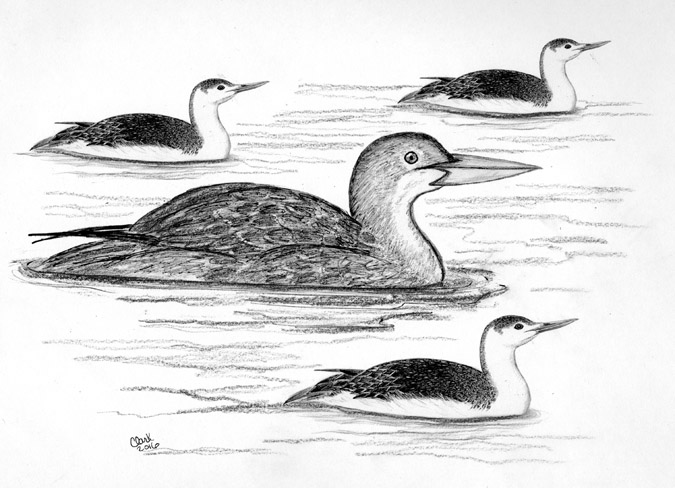
Dear Bird Folks,
I heard on the radio that local birders are all excited about a loon that was spotted in Provincetown. Why all the excitement? Is it because loons aren’t often seen on Cape Cod?
– Ian, Falmouth, MA
Not this time, Ian,
Ordinarily, I would make some kind of wisecrack about there being plenty of loons on Cape Cod…especially on the roads during the summer. But after watching the recent political debates on TV, I decided we all could use a break from that kind of infantile conversation. It’s time for someone to raise the intellectual bar, but whodathunk it would be me?
Local birders are indeed getting excited about a recent loon sighting, but this is not one of those loons we see on postcards. This loon has never been seen before in Massachusetts, ever. The loon in question is a Yellow-billed Loon, a bird that breeds above the Arctic Circle and winters along the coast of Alaska and British Columbia. In the history of the Commonwealth no one has ever seen one of these birds and that includes such notables as Roger Tory Peterson (who used to teach in Brookline), bird author David Sibley (a resident of Concord), and me (a shopkeeper in Orleans). But that all changed at the end of February when a Westborough birder, Steve Arena, bravely ventured out onto a secluded section of Provincetown’s Race Point Beach and made the exciting discovery. (Well, exciting by birder standards).
New Hampshire, Maine, and other northern states are all known for their summer loon populations. Yet many folks don’t realize Cape Cod also sees a large number of loons. However, most of our loons are only here in the winter, and instead of living on lakes. they congregate in the ocean. They also tend to go unnoticed because in the winter loons look dull and are not in their more familiar breeding plumage. (Like most Cape Codders, they dress casual when they are here.)
The two loon species most often seen on the cape are Common Loons (the one from On Golden Pond) and Red-throated Loons, plus the occasional Pacific Loon. Two weeks ago, a fourth loon was added to this list. But this is no ordinary lost visitor; it is the largest loon in the world. Tipping the scales at over twelve pounds, Yellow-billed Loons out-weigh such other notably large avian species as the Golden Eagle or four Great Horned Owls put together. (Unfortunately for me, loons only eat fish. Why couldn’t a bird this big crave birdseed instead?)
After hearing about Steve’s discovery, I decided I had to see this giant bird for myself, but the weather in early March was not agreeable for the three-mile round-trip walk along the outer beach. The sea was extremely rough, the temperatures were freezing and the wind was relentlessly blowing. While sizing up the situation, two phrases came to mind. One was, “He who hesitates is lost,” and the other was, “Good things come to those who wait.” I chose the latter; the procrastinator’s option. But plenty of hardcore birders went for it right away. These brave (and foolish) people came back sandblasted and frozen, but they saw the bird. Meanwhile, wimpy (and more sensible) folks like myself had faith that the weather would break. When I heard that an unusually warm stretch of weather was coming, I waited for it…and hoped the loon would wait, too.
The morning I arrived at the Race Point Beach parking lot the temperature was pleasant, the sun was out, the wind was calm and the ocean was smooth. (Good things had come to those who waited.) As I walked along the beach I could see birds everywhere. Eiders, mergansers, grebes, razorbills, scoters and lots of loons all swam and dove just offshore, but none were the bird I was looking for. I stopped to chat with a passing birder who told me that I’d have better luck if I continued up the beach for another mile. At this point a second birder passed me and only said a brief hello. This guy, who had long gray hair, reminded me of David Carradine from the old Kung Fu TV show. He also seemed to be in a hurry as he quickly continued up the beach and eventually disappeared from view.
After about twenty minutes of walking I looked up and saw the kung fu guy sitting on the dune. As I approached him he stood up, pointed towards the ocean and told me that the Yellow-billed Loon was out there. I was a little confused because the water was flat and I did not see a single bird. He kept pointing, so I kept looking further and further out, until somewhere just off the coast of Greenland (or so it seemed) I saw a distant flock of Red-throated Loons. I watched the smaller loons for several minutes, when suddenly the water boiled and up popped a loon that was about the size of the Bismarck. The bird then turned towards me, showing off its distinctive yellow bill. I yelled, “I see it,” but there was no response. The guy was gone. He was continuing his walk up the beach and had only stopped to make sure I saw the bird I was looking for. It was all so very cool…and a little spooky.
My walk out to see the Yellow-billed Loon was an enjoyable adventure, Ian. In addition to seeing an assortment of other birds, I also saw plenty of inquisitive seals and several whales. Maybe you should check it out yourself. All you have to do is park at the Race Point parking lot, turn left and head up the beach for about two miles. If you don’t find the loon, just look for a mysterious kung fu master. He won’t let you down.